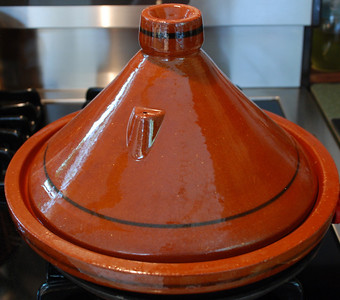Mention Morocco and visions of sweeping sand dunes, loping camels and bustling marketplaces spring to mind. Mention this exotic North African country to me, and I think of russet colored tagines. For me, Morocco is the land of succulent stews and the shallow, clay containers in which they simmer.

Once you spot a tagine in a bustling North African souk or Western cookware shop, you’ll never mistake it for another pot. It consists of two parts: a circular, shallow pan and the large, conical-topped cover that fits inside the base. The cone shape allows condensation to cascade back down to the casserole, creating a rich, reduced sauce. The lid has a small knob on the top, providing cooks with something to grasp when removing the cover to check on the bubbling contents within.
Thanks to its unique design, the tagine encourages low, slow simmering of its contents. Simmering allows diverse flavors to meld together and ensures a tender, juicy, aromatic meal. Cooks must be vigilant, though, and add water as needed. Otherwise, they will end up with a dinner as dry as the desert.
Traditionally comprised of glazed terra cotta, today’s tagines come in materials familiar to the modern cook. Combinations range from stainless steel and aluminum core, courtesy of All-Clad, to cast iron and earthenware from Le Creuset. Unlike the classic clay construction, the new, pricier versions can be placed directly on a burner without the use of a heat diffuser. I must slide a cast iron skillet of comparable size beneath my old-fashioned pot before firing up the stove top.
Note that if you acquire the terra cotta version, you should season it before its first use. To do this, I placed water, olive oil, onions, zucchini and carrots and a sprinkling of spices, including turmeric, cumin and garlic, in the bottom. After plunking on the lid, I slid the pot into a 300-degree oven for 40 minutes. I then removed it and allowed it to cool. After it had reached room temperature, I removed the contents and washed the tagine in preparation for its cooking premiere. Another option is to soak it in hot water overnight, then rub olive oil onto it and place it in a 200-degree oven for 20 minutes.
Properly seasoned and cleaned, tagines yield such succulent meals as chicken with olives and preserved lemons, red snapper with raisins and sweet onions, and a vegetarian fete of soft artichokes, potatoes and peas. Spiced with such ancient seasonings as pepper, ginger and cinnamon, the aroma simultaneously soothes and stimulates the senses. Most tagine recipes also include cumin, onion, garlic and saffron, common Moroccan flavorings.
TAGINE OF CHICKEN, PRESERVED LEMON AND OLIVES
Serves 6
While traditionally prepared in the conical tagine, the recipes that follow can also be made in a Dutch oven or large, shallow, lidded saute pan. The keys to success are in keeping the heat at a low simmer, covering the dish while cooking and making sure the sauce doesn’t bubble away completely.
6 boneless chicken breast halves
1-1/2 large white onions, grated
6 cloves garlic, peeled and crushed
2 teaspoons dried parsley flakes
1 teaspoon crushed coriander seeds
Juice of 1 lemon
5 tablespoons olive oil
2 teaspoons ground ginger
3/4 teaspoon saffron threads
1-1/2 teaspoons sea salt, or to taste
1-1/2 teaspoons ground black pepper, or to taste
Water
1 preserved lemon (see Note)
Handful of picholine olives
Cooked couscous, optional
Place chicken in a bowl. In another bowl, combine onion, garlic, parsley, coriander, lemon juice, olive oil, ginger and saffron, and whisk to mix. Pour marinade over chicken. Cover, refrigerate and allow chicken to marinate for 1 hour.
Place tagine on stove over medium heat. Arrange chicken so that it covers bottom of tagine. Pour marinade over and sprinkle with salt and pepper. Add enough water to cover chicken by two-thirds. Bring water to a boil, then reduce to simmer. Cover and cook about 1 hour, turning chicken over periodically so that it does not brown on one side or stick to pan.
Rinse preserved lemon, then cut into strips. Add lemon and olives to tagine. Cover and cook 10 minutes to reduce sauce and meld flavors. Remove tagine from heat and serve chicken solo, or with couscous on the side, if desired.
Note: Preserved lemons are available at specialty grocery stores and from online food suppliers, such as Faraway Foods (www.farawayfoods.com) and the gourmet food shop at www.amazon.com. Regular lemons have a sweeter flavor and are not recommended for this dish.